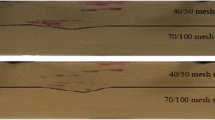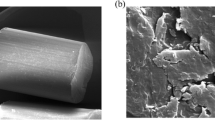Abstract
A series of batch reactor experiments was carried out to examine the effect of a nonaqueous phase liquid (NAPL) on the biodegradation of a hydrophobic solute. A mathematical program model that describes physical processes of solute solubilization and partitioning between the NAPL and aqueous phases as well as microbial degradation and oxygen utilization was used to analyze the test data. The model calculates the cumulative changes in concentration of substrate, cell mass, carbon dioxide, and dissolved oxygen as a function of time. The equations incorporate the effects of solute solubilization, partitioning, biodegradation, as well as oxygen availability. Hexadecane was used as the model NAPL and was not biodegraded in the timeframe of the experiments performed. The model solute was the polyaromatic hydrocarbon, phenanthrene. In agreement with several previous studies, experimental measurements showed that hexadecane increased rates of mineralization of 15 mg phenanthrene when present at low mass but decreased rates at high mass. Model results suggest that partitioning of the phenanthrene into the hexadecane phase limits bioavailability at high NAPL mass. Further the model suggests that mineralization rates were higher with the low NAPL mass because aqueous phenanthrene concentrations were higher in those treatments from ca. 20 to 40 h than in other treatments. Finally, experiments showed that the presence of hexadecane, at all masses tested, resulted in a lower cell yield, effectively increasing the amount of CO2 produced during the experiment. Model results suggest that this is due to changes in phenanthrene metabolism that are induced by the presence of the hexadecane phase. Model studies aimed at increasing rates of biodegradation by modifying operating conditions are described along with practical approaches to implementing these modifications.
Similar content being viewed by others
References
Al-Tahhan R, Sandrin TR, Bodour AA, Maier RM, (2000) Rhamnolipid-induced removal of lipopolysaccharide from Pseudomonas aeruginosa: effect on cell surface properties and interaction with hydrophobic substrates Appl. Environ. Microbiol. 66:3262–3268
Birman I, Alexander M, (1996) Optimizing biodegradation of phenanthrene dissolved in nonaqueous-phase liquids Appl. Microbiol. Biotechnol. 45: 267–272
Carroquino MJ, Alexander M, (1998) Factors affecting the biodegradation of phenanthrene initially dissolved in different nonaqueous-phase liquids Environ. Toxicol. Chem. 17: 265–270
Doick KJ, Semple KT, (2003) The effect of soil:water ratios on the mineralization of phenanthrene:LNAPL mixtures in soil FEMS Microbiol. Lett. 220(1): 29–33
Efroymson RA, Alexander M, (1994) Role of partitioning in biodegradation of phenanthrene dissolved in nonaqueous-phase liquids Environ. Sci. Technol. 28: 1172–1179
Efroymson RA, Alexander M, (1995) Reduced mineralization of low concentrations of phenanthrene because of sequestering in nonaqueous phase liquids Environ. Sci. Technol. 29: 515–521
Fu MH, Alexander M, (1995) Use of surfactants and slurrying to enhance the biodegradation in soil of compounds initially dissolved in nonaqueous-phase liquids Appl. Microbiol. Biotechnol. 43: 551–558
Gamerdinger AP, Achin RS, Traxler RW (1995) Effect of aliphatic nonaqueous phase liquids on naphthalene biodegradation in multiphase systems J. Environ. Qual. 24: 1150–1156
Garcia-Junco M, De Olmeda E, Ortega-Calvo JJ, (2001) Bioavailability of solid and non-aqueous phase liquid (NAPL)-dissolved phenanthrene to the biosurfactant-producing bacterium Pseudomonas aeruginosa 19SJ Environ. Microbiol. 3(9): 561–569
Jahan K, Ahmed T, Maier WJ, (1999) Modeling the influence of nonionic surfactants on biodegradation of phenenanthrene Water Res. 33: 2181–2193
Jimenez IY, Bartha R, (1996) Solvent-augmented mineralization of pyrene by a Mycobacterium sp Appl. Environ. Microbiol. 62: 2311–2316
Kanaly RA, Bartha R, Watanabe K, Harayama S, (2000) Rapid mineralization of benzo[a]pyrene by a microbial consortium growing on diesel fuel Appl. Environ. Microbiol. 66(10): 4205–4211
Kanaly RA, Bartha R, Watanabe K, Harayama S, (2001) Enhanced mineralization of benzo[a]pyrene in the presence of nonaqueous phase liquids Environ. Toxicol. Chem. 20: 498–501
Kohler A, Schuttoff M, Bryniok D, Knackmuss HJ, (1994) Enhanced biodegradation of phenanthrene in a biphasic culture system Biodeg 5: 93–103
Labare MP, Alexander M, (1995) Enhanced mineralization of organic compounds in nonaqueous phase-liquids Environ. Toxicol. Chem. 14: 257–265
Marinucci AC, Bartha R, (1979) Apparatus for monitoring the mineralization of volatile 14C-labeled compounds Appl. Environ. Microbiol. 38: 1020–1022
Morrison DE, Alexander M, (1997) Biodegradability of nonaqueous-phase liquids affects the mineralization of phenanthrene in soil because of microbial competition Environ. Toxicol. Chem. 16: 1561–1567
Ortega-Calvo JJ, Birman I, Alexander M, (1995) Effect of varying the rate of partitioning of phenanthrene in nonaqueous-phase liquids on biodegradation in soil slurries Environ. Sci. Technol. 29: 2222–2225
Papageorgakopoulou H, Maier WJ, (1984) A new modeling technique and computer-simulations of bacterial growth Biotechnol. Bioeng. 26: 275–284
Prabhu Y, Phale PS, (2003) Biodegradation of phenanthrene by Pseudomonas sp strain PP2: novel metabolic pathway, role of biosurfactant and cell surface hydrophobicity in hydrocarbon assimilation Appl. Microbiol. Biotechnol. 61: 342–351
Woo SH, Rittman BE, (2000) Microbial energetics and stoichiometry for biodegradation of aromatic compounds involving oxygenation reactions Biodegradation 11:213–227
Zhang Y, Maier WJ, Miller RM, (1997) Effect of rhamnolipids on the dissolution, bioavailability and biodegradation of phenanthrene Environ. Sci. Technol. 31:2211–2217
Zhang Y, Miller RM, (1994) Effect of a Pseudomonas rhamnolipid biosurfactant on cell hydrophobicity and biodegradation of octadecane Appl. Environ. Microbiol. 60:2101–2106
Acknowledgements
This research was supported in part by grant 2 P42 ESO4940-11 from the National Institute of Environmental Health Sciences, NIH, and in part by grant CHE-0133237 from the National Science Foundation.
Author information
Authors and Affiliations
Corresponding author
Rights and permissions
About this article
Cite this article
Sandrin, T., Kight, W., Maier, W. et al. Influence of a nonaqueous phase liquid (NAPL) on biodegradation of phenanthrene. Biodegradation 17, 423–435 (2006). https://doi.org/10.1007/s10532-005-9013-y
Received:
Accepted:
Published:
Issue Date:
DOI: https://doi.org/10.1007/s10532-005-9013-y




